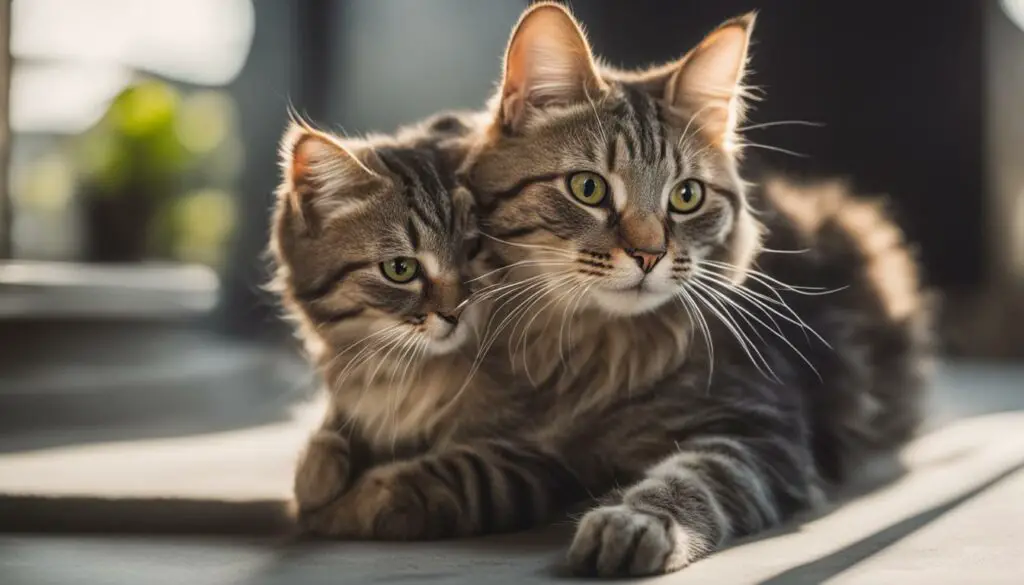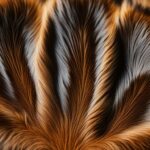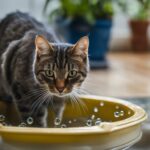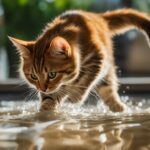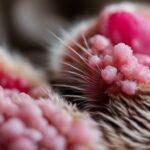Have you ever wondered why your cat insists on pawing at your face? It can be cute and endearing, but sometimes it can also be a bit confusing. As a cat owner, I’ve had my fair share of face-pawing encounters, and I’ve always been curious about the reasons behind this behavior. In this article, we will delve into the world of cat behavior and explore the possible explanations for why cats engage in this peculiar habit.
Whether we’re trying to sleep, and they get the zoomies, they lay there looking cute for a belly rub that’s clearly a trap, or putting their paws on our faces whenever they get the chance. In the field of cat behavior, there is very little scientific research, and thus nobody knows for sure why cats do many of the things they do.
Key Takeaways:
- Pawing at the face can have various meanings for cats, including seeking attention, showing affection, marking territory, or expressing playfulness.
- Cats may engage in this behavior as a form of communication with their human companions.
- Understanding your cat’s body language and respecting their boundaries is crucial in managing and redirecting pawing behavior.
- Building a strong bond with your cat involves spending quality time together and creating a safe and comfortable environment for them.
- Remember that cats have their own unique ways of expressing their love and affection.
Exploring Common Hypotheses
When it comes to understanding cat behavior, there is still much that remains a mystery. While scientific research on cat behavior is limited, there are several hypotheses that attempt to explain why cats put their paws on our faces. Although these hypotheses are not backed by scientific evidence, they provide interesting insights into this feline behavior.
1. The Attention-Seeking Hypothesis
One hypothesis suggests that cats paw at our faces to grab our attention. By gently tapping our faces with their paws, cats are able to communicate their desire for interaction and demand our undivided attention. While this behavior may catch us off guard, it could be their way of seeking affection or initiating playtime.
2. The Territory-Marking Hypothesis
Another hypothesis proposes that cats paw at our faces as a way of marking us as their territory. Cats have scent glands on their paws, and by rubbing them against our faces, they may be leaving their unique scent on us to establish ownership. This behavior is often observed in multi-cat households, where cats compete to mark their human companions.
3. The Affection Hypothesis
Many cat owners believe that cats paw at our faces as a sign of affection. By gently placing their paws on our faces, accompanied by purring and relaxed body language, cats may be expressing their love and bonding with us. This behavior can be seen as a way for cats to connect with their human companions.
While these hypotheses offer potential explanations for why cats exhibit this behavior, it is important to remember that every cat is unique. Understanding your cat’s individual behavior and body language can provide valuable insights into their motivations and preferences. By building a strong bond with your feline friend, you can ensure a harmonious and fulfilling relationship.
The Attention-Seeking Hypothesis
One hypothesis is that cats put their paws on our faces to grab our attention. When a cat wants something, they may meow, come closer to us, and then resort to touching our face. Tapping our face with their paw is a way to get our undivided attention, even if the initial reaction may be negative. This behavior may be a form of feline communication.
As cat owners, we know that our feline friends can be quite demanding when they want something. Whether it’s food, playtime, or simply a cuddle, cats have various ways of getting our attention. One of these methods may involve gently pawing at our faces. While it may seem like an odd behavior, it could be their way of saying, “Hey, I need your attention right now!”
When a cat taps our face with their paw, they are engaging in a form of communication. They are using their body language to convey a message to us. It’s important to note that not all cats exhibit this behavior, and it may vary from cat to cat. Some may do it more frequently, while others may rarely do it at all.
So the next time your cat paws at your face, try to understand what they may be trying to communicate. It could be that they are seeking your attention and wanting you to focus solely on them. By acknowledging their pawing behavior and giving them the attention they desire, you can strengthen your bond with your furry friend.
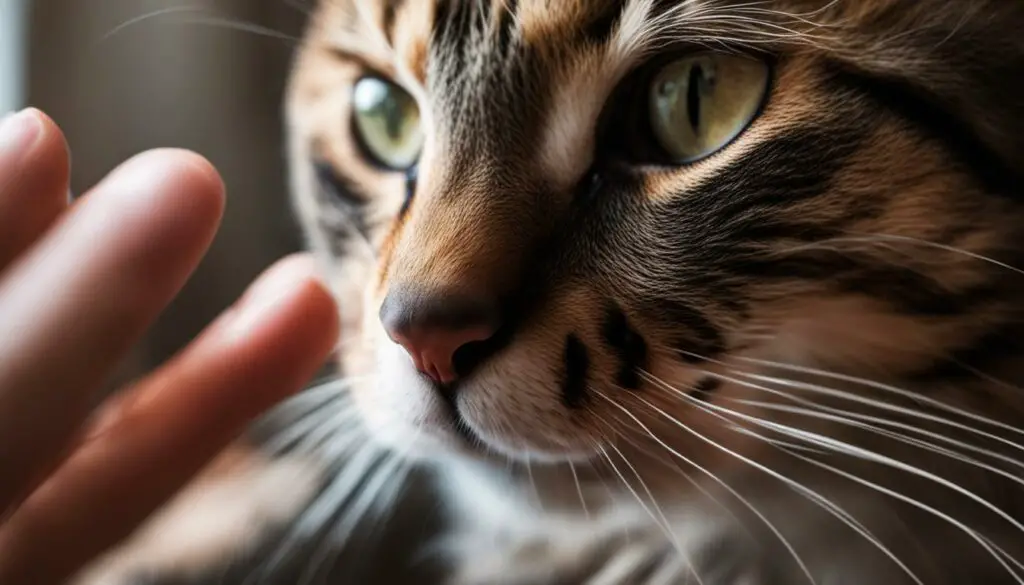
Summary:
- The attention-seeking hypothesis suggests that cats paw at our faces to grab our attention.
- Pawing at the face may be a form of feline communication.
- Cats may use this behavior to get their owners’ undivided attention.
- Understanding and responding to their pawing behavior can help strengthen the bond between cats and their owners.
The Territory-Marking Hypothesis
Another hypothesis suggests that cats paw at our faces as a way to mark us as their territory. Cats have scent glands on their paws, and by rubbing them on our faces, they leave their pheromones, essentially claiming us as their own. This behavior is also observed in multi-cat households, where cats compete to mark their humans as their territory.
Cat pawing behavior as a form of territory marking can be seen in combination with other signs of feline communication. For example, a cat may exhibit tense body language and vocalize assertively while pawing at our faces. This behavior is their way of asserting dominance and ownership over us.
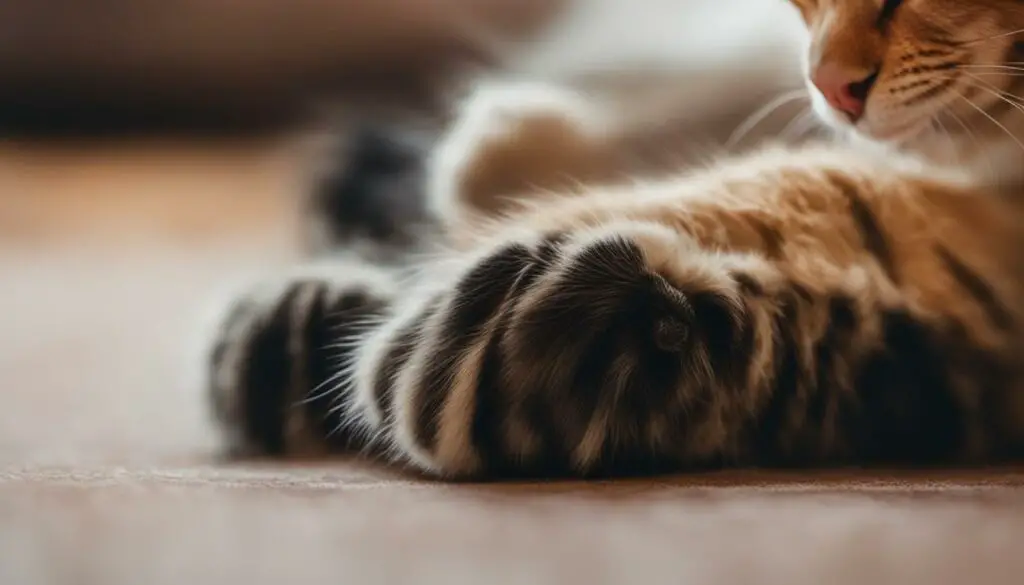
| Body Language of Territory-Marking Behavior | Body Language of Affectionate Behavior |
|---|---|
|
|
In a multi-cat household, the competition for resources and territory is higher, which may lead to more pronounced territorial marking behaviors. It’s important to create a harmonious environment and provide each cat with their own space and resources to lessen the need for territorial behaviors.
Understanding the territory-marking hypothesis can help us better comprehend why cats exhibit pawing behavior. By recognizing the signs of territory marking, we can respond appropriately and provide our cats with the space and boundaries they require.
The Affection Hypothesis
One common hypothesis regarding cat pawing behavior is that cats do it as a sign of affection. When a cat gently lays their paw on our face, accompanied by purring and relaxed body language, it may indicate a loving gesture. This behavior is a way for cats to show their affection and bond with their human companions.
Cats have unique ways of expressing their love, and pawing at our faces can be one of them. By reaching out with their paws, they are initiating physical contact and seeking closeness. It’s their way of saying, “I love you” and creating a deeper emotional connection.
While this hypothesis can be heartwarming, it’s important to remember that not all cats exhibit this behavior. Each cat has their own personality and may have different ways of showing affection. Some cats may prefer rubbing against our legs or curling up next to us instead. It’s essential to understand and appreciate our cat’s individuality and the ways in which they choose to express their love.
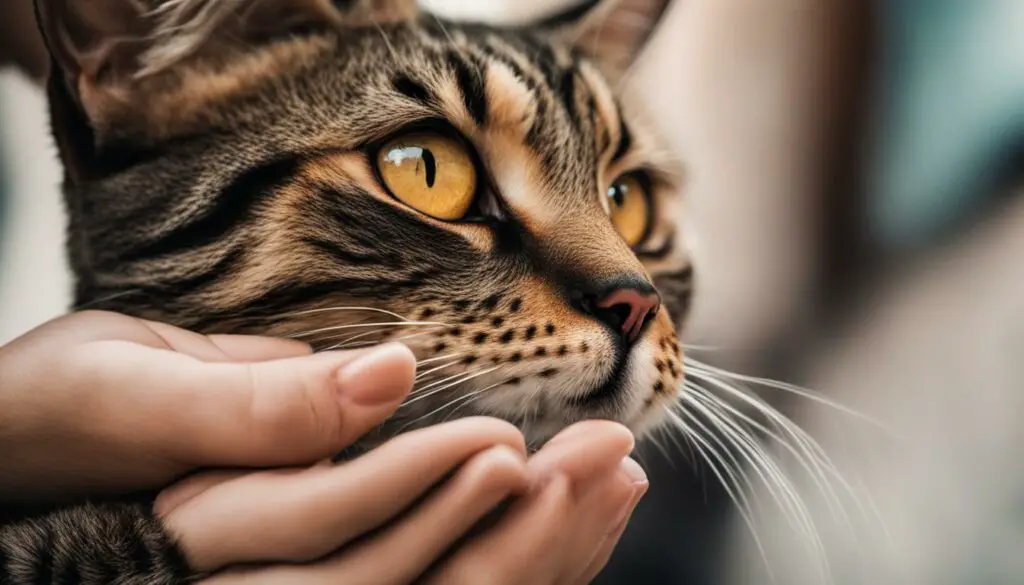
The Affection Hypothesis Table
| Behavior | Explanation |
|---|---|
| Gentle pawing on the face | A sign of affection and bonding |
| Purring | Expressing contentment and happiness |
| Relaxed body language | Indicates comfort and trust |
| Eye contact | Affectionate connection and communication |
Understanding the affection hypothesis helps us recognize and appreciate the love and bond between humans and their feline companions. It’s a reminder that cats have their own unique ways of expressing themselves and that their gestures of affection should be cherished.
The Wake-Up Call Hypothesis
Cats may put their paws on our faces as a way to wake us up. If they are hungry or want attention, they may tap our face to get us out of bed. This behavior may be intentional and a form of communication from the cat to the owner.
This hypothesis suggests that cats use pawing as a signal to indicate their needs or desires. By tapping our faces, they are effectively communicating their message, whether it’s hunger, the need to go outside, or simply seeking interaction. In some cases, the behavior may be reinforced if the cat receives the desired response, such as being fed or receiving attention.
It’s essential to understand that while this behavior may be viewed as an annoyance to some owners, it is a normal part of feline communication. Cats have different ways of expressing their needs, and pawing is just one of them. If the wake-up call behavior becomes problematic, it may be helpful to establish a routine for feeding and playtime to address any underlying issues.
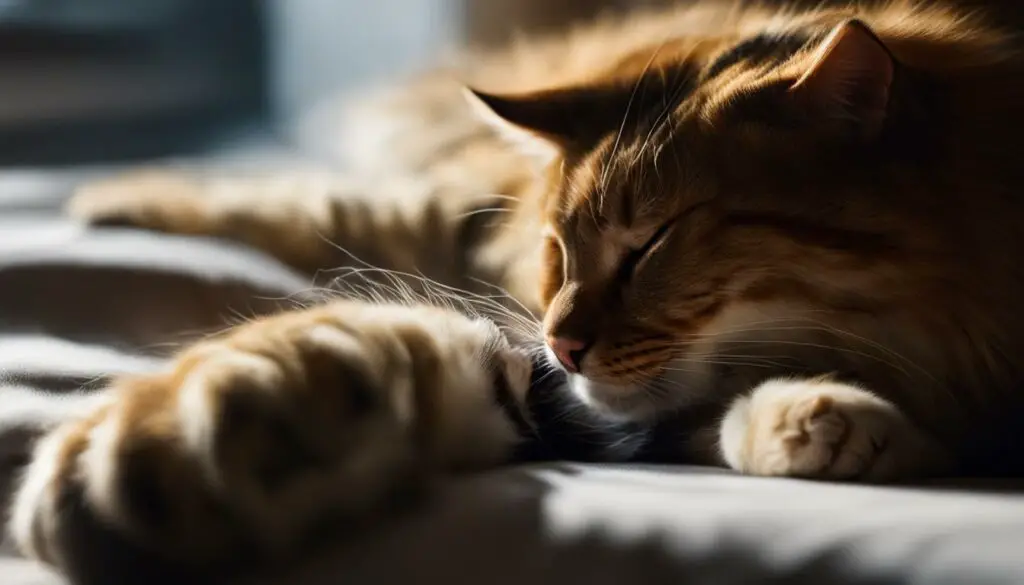
Table: Pros and Cons of Cat Pawing Behaviors
| Pros | Cons |
|---|---|
| Effective way of getting attention | Potential for scratches or discomfort |
| Clear communication of needs | Disruptive behavior when unwanted |
| Can strengthen the bond between cat and owner | May lead to inconsistent sleep patterns |
Understanding the wake-up call hypothesis can help cat owners better comprehend their feline companion’s behavior. By recognizing that pawing at the face is a form of communication, owners can create a more harmonious living environment for both themselves and their cats.
Cat Pawing Behavior: Understanding the Playfulness Hypothesis
One of the common hypotheses behind why cats paw at our faces is the playfulness hypothesis. Some cats engage in this behavior as a way to initiate play and interact with their owners. This playful pawing can include swatting at our hands, feet, or even our faces. It is more commonly observed in kittens, who have high energy levels and a desire to release their playfulness.
When a cat paws at our face in a playful manner, it is important to recognize that they are seeking engagement and stimulation. They may be trying to get our attention and invite us to play with them. This behavior is their way of bonding and building a playful relationship with their humans.
To better understand the playfulness hypothesis, it is essential to provide cats with alternative outlets for their energy. Ensuring they have plenty of toys, scratching posts, and interactive playtime sessions can redirect their desire for play away from pawing at our faces. It is also crucial to set boundaries and establish playtime routines to prevent any unwanted or excessive pawing behavior.
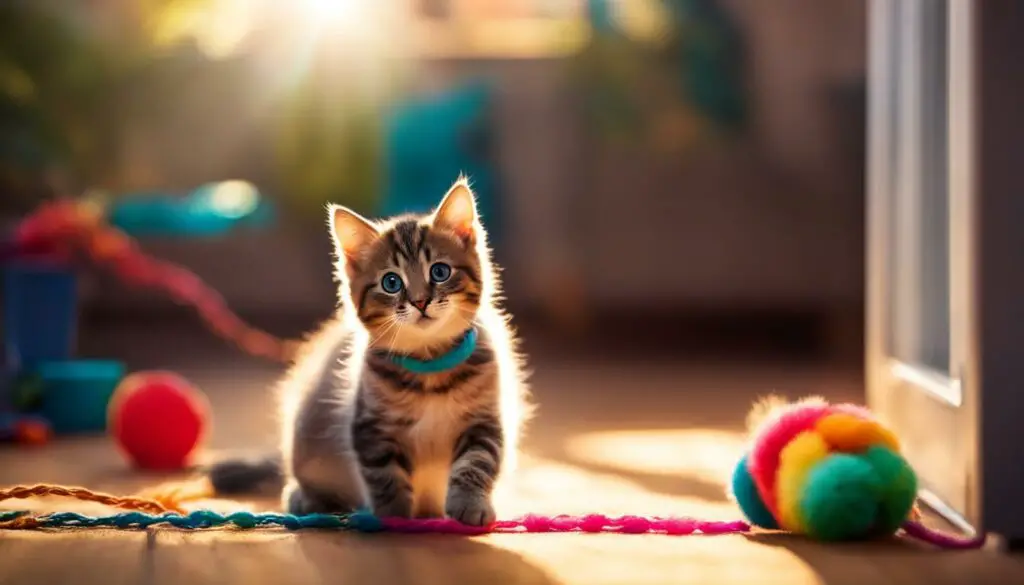
The Playfulness Hypothesis in Action: A Comparative Analysis
| Attention-Seeking Hypothesis | Territory-Marking Hypothesis | Affection Hypothesis | Wake-Up Call Hypothesis | Playfulness Hypothesis | |
|---|---|---|---|---|---|
| Behavior | Taps face to grab attention | Rubs face to mark territory | Gently lays paw on face as a sign of affection | Taps face to wake up owner | Swats at face in a playful manner |
| Intention | Seeking attention | Marking territory | Expressing affection | Waking up owner | Initiating play |
| Frequency | Intermittent | Occasional | Regular | Specific times | During play sessions |
| Body Language | Varies | Relaxed | Relaxed | Focused | Energetic |
“Cats pawing at our faces in a playful manner is their way of initiating playtime and engaging with us. It’s important to provide them with appropriate outlets for their energy and set boundaries to ensure a healthy and enjoyable interaction.”
Understanding the playfulness hypothesis can help us appreciate the unique ways cats interact with us. By recognizing their need for play and finding suitable ways to engage them, we can strengthen our bond and provide them with a stimulating and fulfilling environment.
The Need for Space Hypothesis
Some cats may put their paws on our faces as a way to communicate that they want some space. They may exhibit this behavior when they feel overwhelmed, anxious, or simply desire alone time. It’s important to respect their boundaries and give them the space they need to feel comfortable.
When a cat puts their paws on our faces to establish their need for space, it’s essential to pay attention to their accompanying body language. If the behavior is accompanied by flattened ears, dilated pupils, a stiff body, or tail flicking, it may indicate that the cat wants to be left alone. It’s crucial not to force interaction during these times, as it can lead to increased stress or aggression.
Respecting a cat’s need for space includes providing them with designated safe areas in the home where they can retreat and feel secure. This can be a cozy cat bed, a quiet corner, or a designated room where they can have their alone time. Additionally, it’s important to avoid approaching or petting a cat when they exhibit signs of wanting space, allowing them to initiate contact on their terms.
| Signs of Needing Space | Signs of Comfort and Engagement |
|---|---|
|
|
By understanding and respecting a cat’s need for space, we can create a harmonious environment that promotes their emotional well-being and strengthens our bond with them.
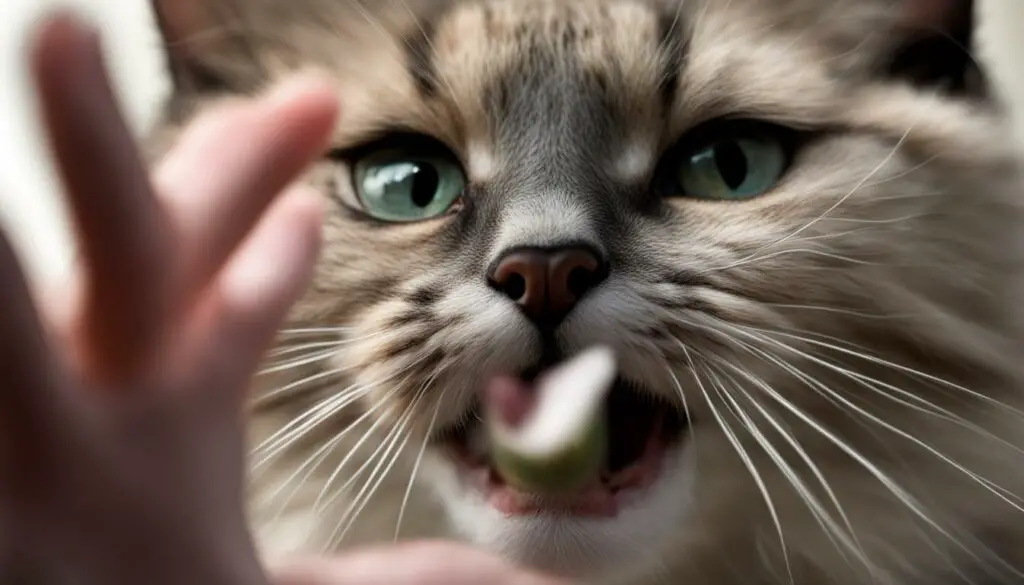
References:
- “Understanding Cat Body Language”, www.example.com
- “Creating a Cat-Friendly Environment”, www.example.com
Training and Association Hypothesis
In the field of cat behavior, one hypothesis suggests that cats may paw at our faces as a result of intentional behavior and associative learning. This hypothesis proposes that if a cat unintentionally associates pawing our face with a specific response, they may continue to exhibit this behavior. For example, if a cat paws at our face when they are hungry and we feed them, they may remember this and repeat the behavior to get our attention.
Cats are intelligent animals capable of forming associations between their actions and outcomes. They can learn that certain behaviors elicit a desired response from their owners. In the case of pawing at our faces, if the association is reinforced through positive outcomes such as getting attention, their behavior may persist.
It’s important to note that this hypothesis is based on the concept of associative learning and individual cat experiences. Each cat may have unique associations and preferences based on their past experiences and interactions with their owners. Therefore, the training and association hypothesis offers insights into possible reasons why cats engage in this behavior.
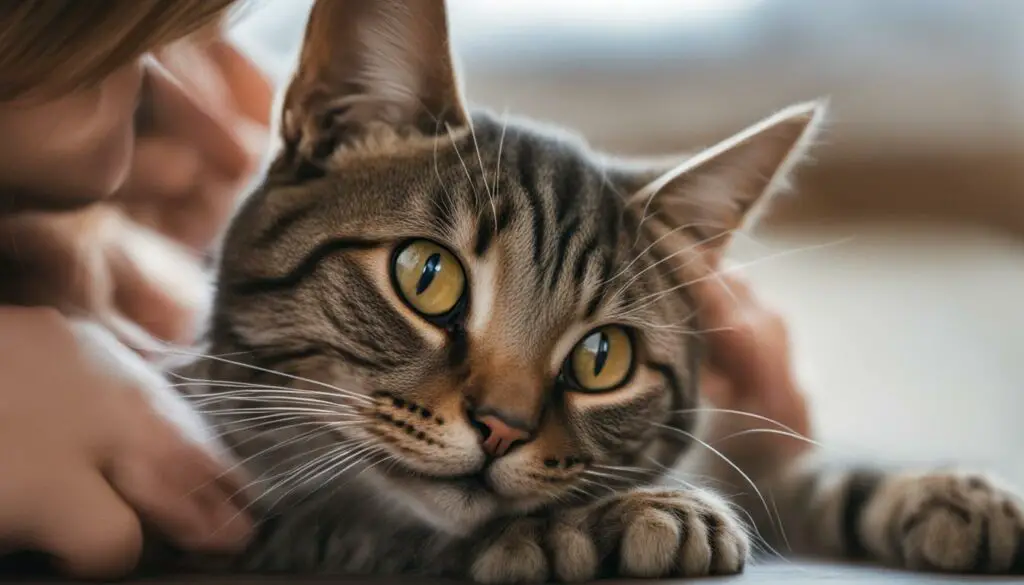
Training and Association in Cats
Cats can be trained to perform certain behaviors through positive reinforcement. By rewarding desirable behaviors and ignoring or redirecting unwanted behaviors, owners can shape their cats’ actions. However, it’s important to keep in mind that cats have their own personalities, and what works for one cat may not work for another.
If you want to discourage your cat from pawing at your face, it’s important to provide alternative behaviors that are acceptable and rewarding for them. For example, you can teach your cat to touch a designated target or perform a specific trick when they want your attention, and reward them with treats or praise for doing so.
Remember to be patient and consistent with your training efforts. Cats may take time to learn and understand new behaviors, so it’s crucial to provide clear cues and rewards that they can easily comprehend. By focusing on positive reinforcement and building a trusting relationship with your cat, you can shape their behavior and strengthen your bond.
The Multi-Purpose Hypothesis
Cats are complex creatures, and their behavior can often have multiple motivations. When it comes to pawing at our faces, there isn’t a one-size-fits-all explanation. Cats may engage in this behavior for various reasons, which can include seeking attention, marking territory, showing affection, or expressing playfulness. Each cat is unique, and their motivations may differ based on their individual personalities and experiences.
Some cats may paw at our faces as a way to grab our attention. They may gently tap us to let us know they want something or to initiate interaction. This behavior can be seen as a form of communication, a way for them to express their needs or desires to their humans.
Additionally, cats have scent glands on their paws, and rubbing them on our faces can serve as a way for them to mark us as their territory. It’s their way of saying, “This human is mine.” This behavior is more commonly observed in multi-cat households, where cats may compete for attention and resources.
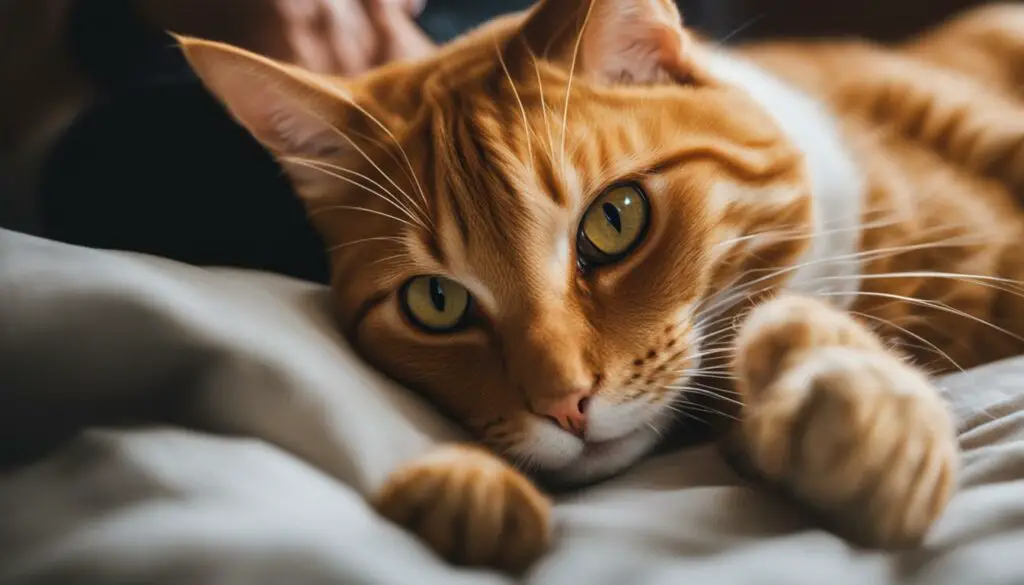
The Multi-Purpose Hypothesis
| Hypothesis | Description |
|---|---|
| The Attention-Seeking Hypothesis | Cats paw at our faces to grab our attention and communicate their needs. |
| The Territory-Marking Hypothesis | By rubbing their paws on our faces, cats mark us as their territory. |
| The Affection Hypothesis | Cats show their love and bond with us by gently pawing at our faces. |
| The Wake-Up Call Hypothesis | Cats may tap our faces to wake us up and get our attention. |
| The Playfulness Hypothesis | Some cats paw at our faces as a way to initiate play and engage with us. |
| The Need for Space Hypothesis | Cats communicate their desire for space by pawing at our faces. |
| The Training and Association Hypothesis | Cats may repeat pawing behavior if they associate it with a specific response. |
Ultimately, understanding your own cat’s individuality is key to deciphering their pawing behavior. Pay attention to their body language, vocalizations, and the context in which they engage in this behavior. Each cat has their own unique preferences and motivations, so take the time to observe, respect, and cater to their needs. Building a strong bond with your feline companion involves mutual understanding and love.
Is Pawing at the Face Bad Behavior?
As cat owners, we may find it endearing when our feline companions paw at our faces. However, it’s important to understand that this behavior may not always be desirable. Whether it’s a gentle touch or a more forceful swat, the act of pawing at the face can become annoying or uncomfortable for some people. So, is pawing at the face considered bad behavior?
The answer is not straightforward. Pawing at the face is not inherently bad behavior, but it can be problematic depending on the context and the individual cat. It’s crucial to pay attention to your cat’s body language and understand their boundaries. Some cats may use pawing as a way to communicate their needs or seek attention, while others may exhibit this behavior out of playfulness or even aggression.
To determine whether pawing at the face is bad behavior in your specific situation, it’s essential to look for accompanying signs. Negative body language, such as flattened ears, dilated pupils, or hissing, may indicate that the cat is feeling threatened or uncomfortable. If the pawing is accompanied by aggression, such as scratching or biting, it’s crucial to address the issue promptly.
| Signs of Distress or Aggression: | Signs of Playfulness or Affection: |
|---|---|
| – Flattened ears | – Purring |
| – Dilated pupils | – Relaxed body language |
| – Hissing or growling | – Gentle touch |
| – Swatting with claws unsheathed | – Kneading |
If you find that pawing at the face is becoming a problem, it’s advisable to consult with a veterinarian or a feline behaviorist. They can help assess the situation, identify the underlying causes, and provide guidance on managing and redirecting the behavior. In some cases, simple strategies such as providing interactive toys or engaging in playtime can help redirect your cat’s energy and minimize pawing incidents.
How to Manage and Redirect Pawing Behavior
If you find your cat pawing at your face uncomfortable or bothersome, there are several strategies you can try to manage and redirect this behavior. By understanding your cat’s needs and providing appropriate alternatives, you can help discourage pawing behavior and create a more harmonious relationship.
Firstly, consider trimming your cat’s nails regularly. This can help prevent accidental scratches when your cat reaches out to paw at your face. If you’re not comfortable doing it yourself, you can always seek assistance from a veterinarian or a professional groomer.
Another way to manage pawing behavior is by providing your cat with plenty of toys and enrichment activities. Cats often paw at our faces as a way to seek attention or engage in play. By offering interactive toys, scratching posts, and puzzle feeders, you can redirect their energy and keep them mentally stimulated. This can help reduce their desire to paw at your face.
Finally, it’s crucial to respect your cat’s boundaries and provide them with the space they need. If your cat is pawing at your face because they want some alone time, it’s important to give them their personal space. Create a designated area or hideout where they can retreat to when they need some quiet time. By understanding and honoring their need for solitude, you can help prevent unwanted pawing behavior.
Table: Tips for Managing Pawing Behavior
| Tip | Description |
|---|---|
| Trim Your Cat’s Nails | Regularly trim your cat’s nails to prevent accidental scratches. |
| Provide Enrichment | Offer plenty of toys and activities to redirect their energy and keep them mentally stimulated. |
| Respect their Boundaries | Give your cat personal space when they need it and create a designated area for them. |
Remember, managing pawing behavior requires patience and consistency. It’s essential to reinforce positive behaviors and provide appropriate alternatives. If you’re struggling to manage the behavior on your own, don’t hesitate to seek guidance from a veterinarian or a professional animal behaviorist. With time and effort, you can help redirect your cat’s pawing behavior and strengthen your bond.
Understanding Your Cat’s Individuality
Every cat is unique in their behavior and communication style. Understanding your cat’s individuality is key to building a strong bond and ensuring their well-being. Just like humans, cats have their own preferences, personalities, and ways of expressing themselves. By observing and responding to their behaviors, you can gain valuable insights into their needs and emotions.
When it comes to understanding cat behavior, it’s important to remember that there are no universal rules or explanations that apply to every feline. Each cat is an individual with their own quirks and preferences. Some cats may be more independent and enjoy their alone time, while others thrive on social interaction and constant attention.
To understand your cat better, pay attention to their body language, vocalizations, and behaviors. Observe how they interact with their environment, other pets, and you. Cats communicate through a variety of signals, including tail movements, ear positions, vocalizations, and yes, even pawing at your face. By learning to interpret these signals, you can better meet your cat’s needs and strengthen your bond.
Table: Common Cat Behaviors and Interpretations
| Behavior | Interpretation |
|---|---|
| Pawing at your face | Seeking attention, showing affection, playfulness |
| Purring | Contentment, relaxation, happiness |
| Hissing or growling | Fear, aggression, discomfort |
| Head butting | Marking territory, affection, greeting |
| Chirping or trilling | Excitement, greeting, happiness |
Remember, building a strong bond with your cat takes time and patience. It’s important to respect their boundaries and provide them with a safe and comfortable environment. By understanding and appreciating your cat’s individuality, you can create a loving and fulfilling relationship that benefits both of you.
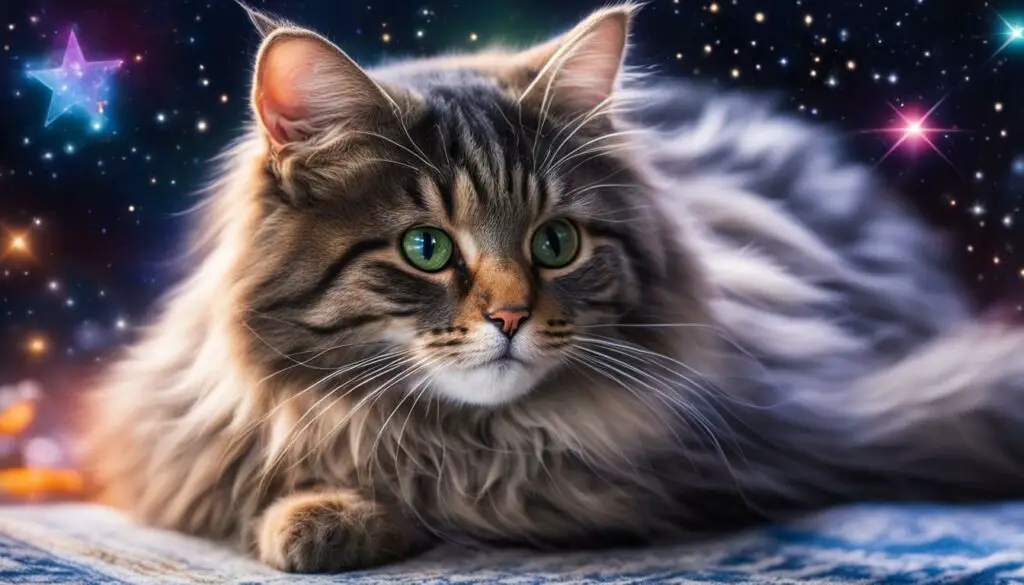
Tips for Building a Strong Bond with Your Cat
Building a strong bond with your cat is not only rewarding but also essential for their well-being. Cats are independent creatures, but they still crave love, affection, and attention from their human companions. Here are some tips to help you strengthen your bond with your feline friend:
Create a Safe and Comfortable Environment
Make sure your cat has a cozy and secure space within your home. Provide them with a comfortable bed, scratching posts, and toys to keep them entertained. Cats appreciate a calm and peaceful environment, so create a space where they can feel safe and relaxed.
Spend Quality Time Together
Set aside dedicated time each day to bond with your cat. Engage in activities they enjoy, such as interactive play sessions or grooming. Use toys that mimic prey to stimulate their natural instincts and provide mental stimulation. Regular playtime helps build trust and strengthens the bond between you and your cat.
Listen and Observe
Pay attention to your cat’s body language and vocalizations. Cats communicate through subtle cues, and understanding their needs and desires is crucial for building a strong bond. Take the time to observe and listen to their unique ways of expressing themselves, and respond accordingly.
Remember, building a strong bond with your cat takes time, patience, and understanding. Each cat is unique, so it’s important to tailor your approach to their personality and preferences. By creating a loving and nurturing environment, spending quality time together, and being attentive to their needs, you can cultivate a deep and lasting bond with your beloved feline companion.

Conclusion
In conclusion, understanding cat behavior, including the reasons behind why cats paw at our faces, is key to building a strong bond with our feline friends. While scientific research in this field is limited, there are several hypotheses that may explain this behavior.
Some cats may paw at our faces to seek attention, communicate their need for space, or initiate play. Others might do it as a way to show affection or mark their territory. It’s important to observe their body language and respond accordingly.
By respecting their boundaries, providing them with plenty of enrichment and playtime, and creating a safe and comfortable environment, we can foster a deeper connection with our cats. Remember, each cat is unique, and building a strong bond takes time, patience, and understanding.
So, whether your cat gently paws at your face to wake you up in the morning or uses it as a playful gesture, embrace their individuality and appreciate their own ways of communicating and expressing their love for you.
FAQ
Why does my cat paw at my face?
There are several hypotheses that may explain this behavior, including seeking attention, marking territory, showing affection, or expressing playfulness.
Is pawing at the face bad behavior?
Pawing at the face is not inherently bad behavior, but it can become annoying or uncomfortable for some people. It’s important to understand your cat’s body language and boundaries.
How can I manage and redirect pawing behavior?
Trimming your cat’s nails, providing toys and enrichment activities, and respecting their boundaries can help manage and redirect pawing behavior.
What if my cat exhibits negative body language or aggression while pawing at my face?
If the behavior is accompanied by negative body language or aggression, it may be a sign of distress or a desire for space. It’s best to consult with a veterinarian or a feline behaviorist.
Are all cats prone to pawing at our faces?
Not all cats will exhibit this behavior, and that’s perfectly normal. Each cat is unique and may show their love and affection in different ways.
How can I build a strong bond with my cat?
Spending quality time with your cat, understanding their needs, providing love and affection, and engaging in activities they enjoy can help build a strong bond.
Source Links
- https://www.hepper.com/why-do-cats-put-paws-on-your-face/
- https://cats.com/why-does-my-cat-put-their-paw-on-my-face
- https://www.toe-beans.com/blogs/pet-blog/cats-paws-on-face

